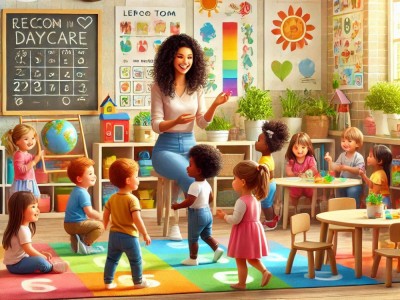Environmental print refers to the print that children see in their everyday environment, such as signs, logos, labels, and symbols. The following article provides information on Benefits Of Environmental Print, Incorporating Environmental Print in Early Childhood Settings, Examples Of Environmental Print, Activities Related To Environmental Print, Linking To The EYLF and more.
Benefits Of Environmental Print
Environmental print plays a significant role in supporting young children's literacy and cognitive development. Here are some ways it helps:
-
Early Literacy Skills: Environmental print helps children recognize that print carries meaning. Seeing words in their environment, such as signs, labels, and logos, helps them understand that written words represent objects, actions, and concepts.
-
Print Awareness: By interacting with environmental print, children develop print awareness, which includes understanding how to handle books, recognizing print in their environment, and knowing the directionality of reading (left to right, top to bottom).
-
Vocabulary Development: Environmental print introduces children to new words and expands their vocabulary. For example, recognizing a stop sign or reading labels on food packages helps children learn new words and their meanings.
-
Contextual Learning: Environmental print provides context for learning new words and concepts. Children can see how words are used in real-life situations, making learning more relevant and meaningful.
-
Phonemic Awareness: Interacting with environmental print can help children develop phonemic awareness, which is the ability to hear, identify, and manipulate individual sounds in spoken words. Recognizing familiar words and logos helps children break down words into smaller sounds.
-
Print Motivation: Seeing print in their environment can motivate children to read and write. Familiar logos and signs can spark interest and curiosity, encouraging children to engage with print.
-
Confidence and Independence: As children begin to recognize and understand environmental print, they gain confidence in their reading abilities. This sense of achievement can motivate them to explore more challenging texts and foster a love for reading.
-
Integration with Other Learning: Environmental print can be integrated into various learning activities, such as storytelling, dramatic play, and arts and crafts, making learning more engaging and interactive.
By incorporating environmental print into early childhood settings, educators can create a print-rich environment that supports young children's literacy development and fosters a love for reading and learning.
Incorporating Environmental Print in Early Childhood Settings
-
Label Classroom Objects: Labeling items in the classroom, such as furniture, toys, and learning centers, helps children make connections between words and objects.
-
Create a Print-Rich Environment: Display environmental print around the classroom, such as posters, charts, and signs. This can include street signs, food labels, and logos.
-
Word Hunts: Take children on a "word hunt" around the school or neighborhood to find and identify environmental print. This can include signs like "EXIT," "STOP," and "BATHROOM."
-
Snack and Lunch Containers: Use food packaging to teach children about print. Point out words on snack and lunch containers and discuss their meanings.
-
Interactive Activities: Create activities that involve environmental print, such as matching games, sorting activities, and creating books with cut-out labels and logos.
Examples Of Environmental Print
- Attach a label with the word "Door" on the classroom door and encourage children to read it whenever they enter or exit.
- A board titled "Signs We See" can display pictures of common signs like "Stop," "Exit," and "No Parking."
- Provide children with a checklist of words and symbols to find, such as "Exit," "Restroom," and "Recycle."
- During snack time, point out and read labels on containers like "Juice," "Crackers," or "Fruit Snacks."
- Create a book titled "My Favorite Snacks" with pages featuring labels from children’s favorite snack foods.
- Create a matching game where children match logos to the corresponding product images.
- In the dramatic play area, include menus from local restaurants or signs for a pretend grocery store.
- Interactive apps or websites where children can match signs and labels to their meanings.
Activities Related To Environmental Print
Here are some engaging activities to incorporate environmental print into early childhood settings:
-
Label Hunt:
-
Activity: Give children a list of common items around the classroom or home, labeled with print (e.g., "chair," "door," "table"). Encourage them to find and read the labels.
-
Objective: Helps children associate words with objects and develop their reading skills.
-
-
Print Walk:
-
Activity: Take children on a walk around the neighborhood or school to identify signs, labels, and logos. Create a checklist of items to find, like "Stop sign," "Exit," and "Store sign."
-
Objective: Enhances observation skills and print recognition in real-world contexts.
-
-
Environmental Print Collage:
-
Activity: Collect labels, logos, and signs from magazines, food packages, and advertisements. Provide children with glue and paper to create a collage.
-
Objective: Encourages creativity and reinforces the recognition of familiar print.
-
-
Story Time with Environmental Print:
-
Activity: Read books that incorporate environmental print, such as "I Read Signs" by Tana Hoban or "The Neighborhood Mother Goose" by Nina Crews. Discuss the signs and labels featured in the story.
-
Objective: Connects reading with real-life print and enhances vocabulary.
-
-
Interactive Bulletin Board:
-
Activity: Create a bulletin board with a theme like "Our Community" and include pictures of local signs, logos, and labels. Add pockets or Velcro strips so children can match words to pictures.
-
Objective: Encourages interactive learning and word recognition.
-
-
Snack Time Reading:
-
Activity: During snack time, read labels on food packages together. Discuss what the words mean and how they relate to the contents.
-
Objective: Builds vocabulary and comprehension skills.
-
-
Environmental Print Bingo:
-
Activity: Create bingo cards with pictures of common signs and labels. As you go on a walk or explore the classroom, children can mark off the items they find.
-
Objective: Makes learning fun and reinforces the recognition of environmental print.
-
-
Environmental Print Matching Game:
-
Activity: Create a matching game using pairs of cards with pictures of signs, logos, or labels. Children match the cards based on their understanding of the print.
-
Objective: Develops memory and print recognition skills.
-
-
Role-Playing Games:
-
Activity: Set up a pretend grocery store, post office, or restaurant with real or recreated signs, labels, and menus. Children can role-play and use the print in their activities.
-
Objective: Encourages practical use of environmental print and social interaction.
-
These activities can help young children understand the importance of print in their everyday lives, develop their early literacy skills, and make learning engaging and fun.
Linking To The EYLF
Linking environmental print activities to the Early Years Learning Framework (EYLF) can enhance children's learning experiences by aligning them with key learning outcomes. Here are some ways to integrate environmental print with the EYLF:
-
Learning Outcome 1: Children have a strong sense of identity
-
Activity: Labeling personal items and spaces in the classroom.
-
Link: Helps children develop a sense of belonging and ownership, fostering their emerging autonomy and self-identity.
-
-
Learning Outcome 2: Children are connected with and contribute to their world
-
Activity: Creating a community map with environmental print from the local area.
-
Link: Encourages children to understand their role in the community and promotes social responsibility.
-
-
Learning Outcome 3: Children have a strong sense of wellbeing
-
Activity: Using environmental print in health and safety routines, such as signs for handwashing and emergency exits.
-
Link: Supports children's physical and emotional wellbeing by creating a safe and predictable environment.
-
-
Learning Outcome 4: Children are confident and involved learners
-
Activity: Conducting scavenger hunts for environmental print.
-
Link: Encourages curiosity, problem-solving, and critical thinking skills as children explore and discover print in their environment.
-
-
Learning Outcome 5: Children are effective communicators
-
Activity: Creating a class book with environmental print collected during outings.
-
Link: Enhances communication skills and helps children express ideas and share information with peers.
-
By incorporating environmental print into these activities, educators can create a print-rich environment that supports young children's literacy development and aligns with the EYLF outcomes.
Further Reading
Preschool Indicators Of Literacy and Numeracy
Children's Learning Through Literacy
Creating A Literacy Rich Environment For Children
Developing and Enhancing Literacy in Children
Literacy Activities For Children In Early Childhood
References:
Environmental Print In Early Childhood, Lovely Commotion
What Is Environmental Print, Tender Hearted Teacher







 As an Educator in Australia, your pay rate falls under the Children’s Services Award 2010. This award states the minimum amount that an employer can
As an Educator in Australia, your pay rate falls under the Children’s Services Award 2010. This award states the minimum amount that an employer can When working as a qualified Early Childhood Teacher (with a university degree) within a service, your rate of pay will come from the Educational Services
When working as a qualified Early Childhood Teacher (with a university degree) within a service, your rate of pay will come from the Educational Services When working as a Diploma Qualified Educator your pay rate is from the Children's Services Award 2010. This Award states your minimum rate of pay
When working as a Diploma Qualified Educator your pay rate is from the Children's Services Award 2010. This Award states your minimum rate of pay When working as a Cert 3 Qualified Educator, your pay rate is from the Children's Services Award 2010. This Award states your minimum rate of
When working as a Cert 3 Qualified Educator, your pay rate is from the Children's Services Award 2010. This Award states your minimum rate of Educational Leaders play a crucial role in their early childhood service by ensuring that the educational program aligns with best practices and supports the holistic
Educational Leaders play a crucial role in their early childhood service by ensuring that the educational program aligns with best practices and supports the holistic In early childhood education and care, ratios are more than a technicality—they are a frontline safeguard. Every child deserves responsive supervision, emotional connection, and developmental
In early childhood education and care, ratios are more than a technicality—they are a frontline safeguard. Every child deserves responsive supervision, emotional connection, and developmental Here’s a comprehensive Mobile Phone and Smart Watch Policy tailored for early childhood education and care (ECEC) services in Australia, aligned with the latest 2025
Here’s a comprehensive Mobile Phone and Smart Watch Policy tailored for early childhood education and care (ECEC) services in Australia, aligned with the latest 2025 With the new national child safety reforms kicking in on 1 September 2025, early childhood services like yours have a real opportunity to lead the
With the new national child safety reforms kicking in on 1 September 2025, early childhood services like yours have a real opportunity to lead the The Sea of Fish Challenge is a national initiative that invites children, educators, families, and communities to create and display fish artworks as a symbol
The Sea of Fish Challenge is a national initiative that invites children, educators, families, and communities to create and display fish artworks as a symbol Across the early childhood education and care sector, educators are sounding the alarm: current staffing ratios are insufficient to deliver safe, meaningful, and developmentally appropriate
Across the early childhood education and care sector, educators are sounding the alarm: current staffing ratios are insufficient to deliver safe, meaningful, and developmentally appropriate


